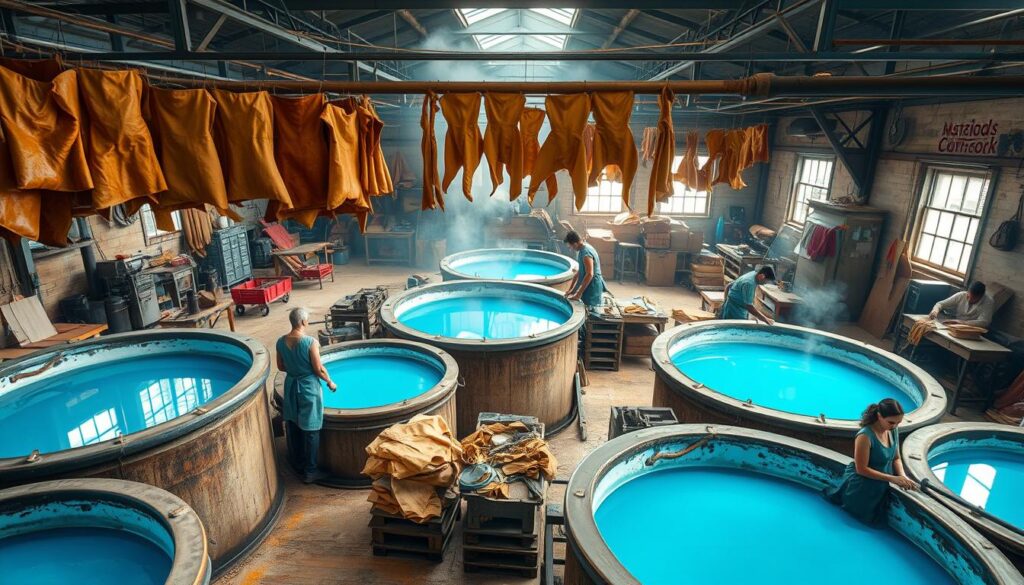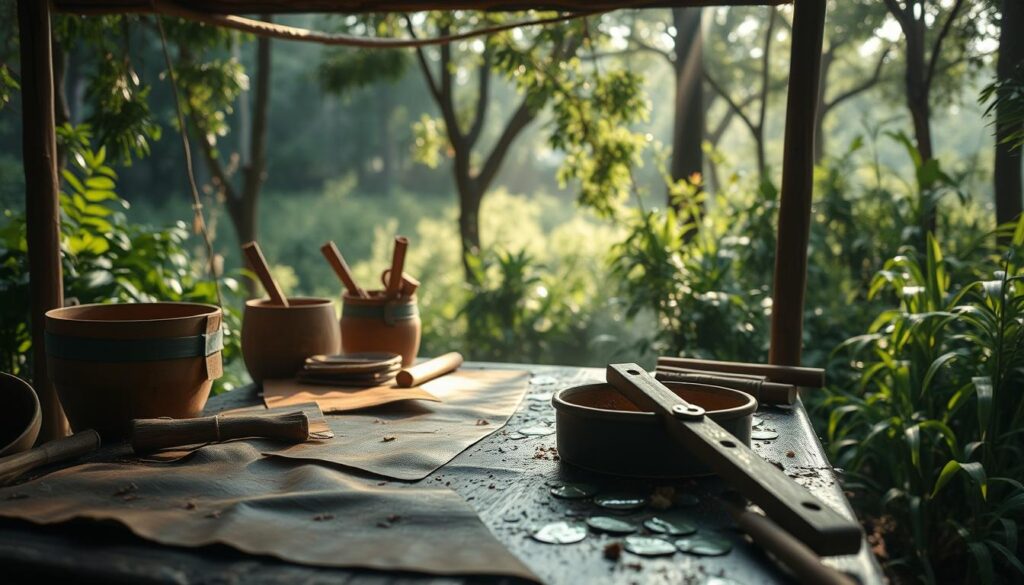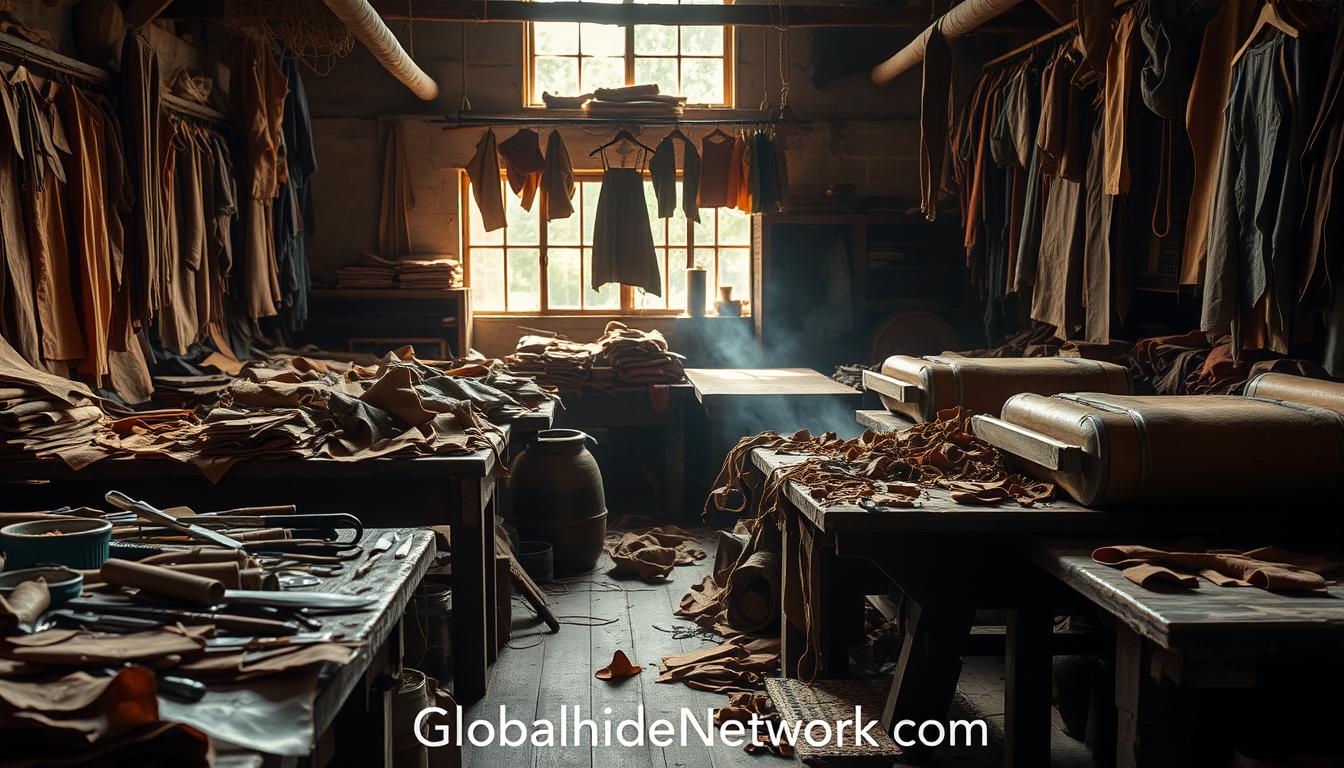I’ve seen more people curious about leather making. They don’t get how raw animal hides become soft, strong leather. This confusion can make them think wrong things about leather’s quality and how it’s made.
Don’t worry! I’m here to clear up the mystery of leather making. We’ll explore everything from preparing the hide to the latest tanning methods. You’ll see the skill and science in this ancient craft.
Key Takeaways
- Chrome tanning dominates 75% of leather production
- Vegetable tanning is the oldest method, using plant extracts
- Tanning methods vary in duration, from hours to months
- Each tanning technique offers unique leather properties
- Environmental impact differs among tanning methods
- Tanning choice depends on desired leather characteristics
- Modern innovations focus on sustainability in leather processing
The Origins of Leather Tanning
I’ve always been fascinated by the history of leather tanning. It started around 8,000 BCE in the early Stone Age. The word “tanning” shows its deep roots in human history.
Etymology of “Tanning”
The word “tanning” comes from medieval Latin “tannāre.” It’s linked to “tannum” or oak bark. This shows how important plant-based tanning was in ancient times.
Historical Significance of Leather
Leather has been key throughout history. In Mehrgarh, Pakistan, people used leather from 7000-3300 BCE. They made waterskins, boats, and even armor from it.
The Romans, around 800 BCE, perfected tanning techniques. They made different types of leather.
Early Tanning Methods
Ancient tanning was quite interesting. People used urine, lime, or let hides rot. Then, they scraped and bated with animal dung.
In Greenland, archaeologists found leather from the fifth century BCE. It was preserved in ice. The tanning method used animal brain, liver, fat, and salt.
| Time Period | Tanning Method | Materials Used |
|---|---|---|
| 8000 BCE | Early Stone Age Tanning | Unknown |
| 3000 BCE | Plant-based Tanning | Mimosa, Chestnut, Bark |
| 800 BCE | Roman Tanning | Alum |
| 5th Century BCE | Greenland Method | Animal Brain, Liver, Fat, Salt |
Preparation of Hides and Skins
Preparing hides is key in making leather. It’s the first step to making top-notch leather products. Let’s look at the main steps to get hides and skins ready for tanning.
Animal Selection and Skinning
Choosing the right animal is the first step. Skinning is a careful process to keep the hide in good shape. It’s important to skin correctly to ensure the leather turns out well.
Initial Cleaning and Preservation
After skinning, the hide gets a deep clean. This removes dirt, blood, and extra tissue. It’s important to act fast to keep the hide quality high.
Salt Curing Techniques
Salt curing is a classic way to preserve leather. I cover the hide in salt to remove moisture. This stops bacteria from growing. There are two ways to do this: wet-salting or brine-curing.
- Wet-salting: Covers hides in salt for about 30 days
- Brine-curing: Uses a saltwater bath for 16 hours
These steps are vital for making great leather. Proper preparation, skinning, and salt curing get the raw material ready for the next steps in leather making.
Beamhouse Operations: The First Steps
I’ve learned that beamhouse operations are key in leather making. They turn raw hides into materials ready for tanning. Let’s explore the main steps.
Soaking is the first step. It rehydrates the hides and removes salt for preservation. Then, liming uses a lime solution to get the hide ready for unhairing.
Unhairing removes hair and some fats from the skin. Next, fleshing takes off any leftover flesh or fat from the hide’s inner side. Deliming then lowers the hide’s pH level.
Finally, bating softens the hide with enzymes. This gets it ready for tanning.
| Operation | Purpose |
|---|---|
| Soaking | Rehydrate hides and remove salt |
| Liming | Prepare hide for unhairing |
| Unhairing | Remove hair and some fats |
| Fleshing | Remove remaining flesh and fat |
| Deliming | Reduce pH level of the hide |
| Bating | Soften hide with enzymes |
These beamhouse steps are vital for preparing the hide for tanning. They make the leather strong, soft, and resistant to decay.
Leather Processing and Tanning Techniques
Leather processing uses different tanning methods. Each method changes the leather’s quality and how it affects the environment.
Chrome Tanning
Chrome tanning is the most common, using chromium sulfate. It makes up 85% of leather made worldwide. This method makes leather soft and stretchy.

Vegetable Tanning
Vegetable tanning uses plants and makes up 10% of leather made. It creates leather with a special look and feel. This method is slower but better for the planet.
Chrome-Free Tanning
Chrome-free tanning, or FOC-tanning, is about 5% of leather made. It includes aldehyde tanning and other alternatives. This method is used for special needs where chrome tanning won’t do.
Each tanning method has its own good points:
- Chrome-tanned leather: More flexible and stretchable
- Vegetable-tanned leather: Unique aesthetics and eco-friendly
- Chrome-free tanned leather: Specialized applications and potentially lower environmental impact
Combination tanning, using both chrome and vegetable tanning, is also popular. It tries to mix the best of both worlds, making leather with great qualities.
The Chemistry Behind Tanning
I find the leather chemistry fascinating. It’s a complex process that turns animal hides into durable materials. The key to this transformation is understanding the collagen structure and how tanning agents work with it.
Collagen Structure and Reactivity
Collagen, the main protein in animal skin, has a unique helical structure. It’s rich in glycine, proline, and hydroxyproline. These amino acids give collagen its strength and flexibility.
When tanning agents are applied, they cross-link the collagen fibers. This process stabilizes the structure. It makes the leather resistant to decay.
Tanning Agents and Their Effects
Different tanning agents lead to varied leather properties. Chrome tanning uses chromium compounds that form complex bonds with collagen. This results in soft, pliable leather.
Vegetable tanning, on the other hand, uses plant-derived polyphenols. These bind to collagen, creating a firmer leather.
| Tanning Method | Agent | Effect on Leather |
|---|---|---|
| Chrome | Chromium compounds | Soft, pliable, water-resistant |
| Vegetable | Plant polyphenols | Firm, traditional look |
| Aldehyde | Organic compounds | Preserves natural color and texture |
The protein modification that occurs during tanning is crucial. It changes the hide’s properties. This makes it more resistant to heat, water, and microbial attack.
This chemistry is what turns a raw hide into the leather we use every day.
Chrome Tanning: The Modern Approach
I’ve always been interested in the chrome tanning process. It changed leather making, making it quicker and better than old ways. Chromium sulfate is key, turning raw hides into strong leather.
The chrome tanning starts with making hexaaquachromium(III) cations. Then, through olation, these cations form polychromium(III) compounds. These compounds link with collagen in the hide, making the leather very durable.
Chrome-tanned leather is very versatile. It can be dyed many colors and keeps its color well. It’s also great at resisting water and stains, perfect for shoes, bags, and furniture.
| Characteristic | Chrome-Tanned Leather | Vegetable-Tanned Leather |
|---|---|---|
| Water Resistance | High | Moderate |
| Flexibility | Very Flexible | Less Flexible |
| Production Time | About a Month | Up to a Year |
| Environmental Impact | Higher | Lower |
| Color Range | Wide | Limited |
Chrome tanning has many good points but also some downsides. It can harm the environment, especially in places with weak rules. The leather world is working hard to be efficient, keep leather strong, and protect the planet.
Vegetable Tanning: Nature’s Way
Vegetable tanning has been around for over 2000 years. It uses natural tannins from trees and plants. This ancient method is still popular today.
Sources of Vegetable Tannins
Natural ingredients make vegetable tanning special. Tannins come from chestnut, sumac, quebracho, mimosa, and oak. Each source adds unique qualities to leather.
The amount of tannins varies. It ranges from 15-20% for small leathers to 40-50% for large ones.
Process and Duration
Vegetable tanning is a traditional craft. It used to take 30 days in tanks. Now, it’s faster, taking 36-48 hours in drums.
The process has five main steps: Riviera works, Tanning, Re-tanning, Drying, and Finishing. It’s a detailed journey that makes leather better.
Unique Characteristics of Vegetable-Tanned Leather
Vegetable-tanned leather is special. It’s durable, has a unique smell, and ages well. It’s also customizable, making it loved by artisans.
Though it costs more, many think it’s worth it. Its quality is unmatched.
| Characteristic | Vegetable Tanning | Chrome Tanning |
|---|---|---|
| Production Time | 40-60 days | 1-2 days |
| Environmental Impact | Eco-friendly | Less environmentally friendly |
| Scent | Aromatic woody smell | Chemical smell |
| Aging Process | Superior aging capability | Less natural aging |
| Market Share | 8% of production | 92% of production |
Environmental Considerations in Leather Tanning
I’ve looked into the environmental side of leather tanning, and it’s really interesting. The leather industry has big challenges with water use, chemicals, and waste. Chrome tanning is fast but worries about chemical spills. Vegetable tanning is better for the planet but uses more water.
Let’s check out some numbers:
| Tanning Method | Environmental Impact | Sustainability Factor |
|---|---|---|
| Chrome Tanning | Releases hazardous chemicals | Low |
| Vegetable Tanning | Uses natural, biodegradable substances | High |
| Aldehyde Tanning | Uses harmful chemicals like formaldehyde | Very Low |
Sustainable leather making is becoming more popular. Companies like Roger Ximenez are at the forefront. They focus on green tanning and use top-notch, vegetable-tanned leather.

Treating tanning waste is key. Did you know making 1kg of leather uses up to 250 liters of water and creates 6.1kg of solid waste? That’s why the industry is moving towards greener ways to lessen its harm to the environment.
Innovations in Leather Processing
I’ve seen some exciting changes in leather processing lately. The industry is moving towards more sustainable practices. I’m impressed by the innovative tanning methods being developed.
Zeology: Zeolite-Based Tanning
One of the most interesting innovations I’ve come across is zeolite tanning. This method uses minerals called zeolites. They have unique water absorption properties.
It’s a chrome-free and heavy metal-free process. This produces sustainable leather with improved comfort and performance.
Sustainable Tanning Practices
The leather industry is embracing other sustainable practices too. I’ve noticed efforts to improve chemical uptake and recycle tanning solutions. They’re also reducing water consumption.
Some companies are even developing bio-based tanning agents. For example, the AVICUERO® System for sustainable leather tanning and dyeing can reduce CO2 emissions by up to 23% compared to traditional chrome tanning.
Another innovative tanning method I’ve learned about is the DyTan® process. It’s a chrome- and metal-free tanning method. It cuts down on process time and energy consumption.
It also improves effluent discharge loads. This makes it a more environmentally friendly option.
These innovative tanning methods are transforming the industry. They’re creating sustainable leather products that are not only eco-friendly but also high-quality and durable. As research continues, I’m excited to see what other breakthroughs will emerge in this field.
Conclusion
I’ve looked into the world of leather tanning, from old times to new ideas. The leather industry is growing, thanks to new tanning methods. Did you know vegetable tanning takes up to three months? But chrome tanning, used today, can finish in just one day.
The move towards green leather is clear. Chrome tanning is common, but eco-friendly methods are growing. Vegetable tanning, used since ancient times, is coming back. It uses plant extracts, a method from 2000 BC!
The leather industry is working to mix old ways with new ones. They want methods that are good for the planet and efficient. From today’s drum containers to tomorrow’s ideas, leather making is always changing. It’s a thrilling time for those who love leather and care about the environment.
